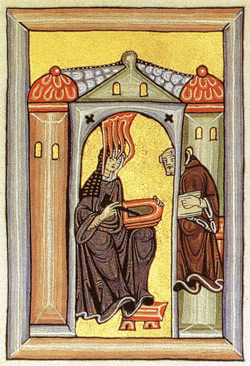Hildegard of Bingen had a close relationship with God. Hildegard was the head of an abbey in the 12th century in what is now Germany. But she was also a seer, a mystic. She had visions. A voice in those visions commanded her to write them down. The result was writing like this:
The soul is kissed by God in its innermost regions.
With interior yearning, grace and blessing are bestowed.
It is a yearning to take on God’s gentle yoke,
It is a yearning to give one’s self to God’s Way.
It is this intimacy, this personal and passionate language, that has made Hildegard a subject of fascination over the ages. Human beings are human beings, whatever the time period, but the 12th century can be a particularly difficult era for the contemporary mind to understand. Life was so very medieval, then. A spirit like Hildegard’s cuts through the historical thickets; for hundreds of years she has continued to be a living, breathing contemporary.
That, presumably, is why Hildegard caught the interest of Margarethe von Trotta. Von Trotta is the German director who made a film called Vision, which tells the story of Hildegard of Bingen. For von Trotta, Hildegard is so sympathetic a figure as to be more or less a 21st-century woman in medieval garb. Speaking about Hildegard, von Trotta said:
She was a highly intelligent woman who nevertheless had to hide her light under her nun’s habit, because, as a woman and a nun, she was not allowed to express herself publicly. … She must have had a very strong subconscious that showed her how to assert herself. … She “used” the visions in order to become known as a seer.
Von Trotta does not suggest the Hildegard made everything up, from her religious faith to her visions, in order to get ahead in a cruel world, but she comes pretty darn close. It is clear that what inspires von Trotta about Hildegard is not the visions as such, but how Hildegard used them. Von Trotta’s movie is, essentially, a story of that usage, a story of how Hildegard made a life for herself and her nuns in a harsh and male-dominated world. And it is a very good story.
What is lost in telling this story, though, is the religious poetry that Hildegard produced. And this brings up a rather profound problem. The very act of retrieving compelling figures from the past can go hand-in-hand with obliterating them. It is like something G. K. Chesterton once said about Saint Francis of Assisi: that we have a way of appreciating the saint almost without the sanctity. Our desire to relate to the saint, to make him modern, threatens to erase some of the profound ways in which his thinking is a challenge to modern mores. To love him, we domesticate him. And in domesticating him, we kill that which made him unique in the first place.
Of course, to leave Hildegard untouched in her medieval strangeness wouldn’t do either. If we are going to be moved by her poetry we have to make some sense of it, make it our own. And thus we are back in the clutches of the dilemma.
If it’s any help, Hildegard does tell us how she imagined herself. She had a vision once of a king sitting on his throne. He picked up a feather and commanded it to fly. And it did fly, simply because the air bore it along, as the air will do. “Thus am I,” said Hildegard, “a feather on the breath of God.” There’s the poetry and the pragmatism of Hildegard all in one. She humbles a king in order to snatch up a beautiful metaphor. For almost a millennium it has been impossible to forget that image, a feather on the breath of God. • 1 November 2010




